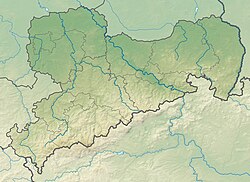The district of Bautzen is a district in the state of Saxony in Germany. Its largest towns are Bautzen, Bischofswerda, Kamenz, Hoyerswerda and Radeberg. It is the biggest district in Saxony by area, and a member of the Neisse Euroregion.
Reutlingen, nicknamed "The Gate to the Swabian Alb", is a Landkreis (district) in the middle of Baden-Württemberg, Germany. The former free imperial city reached the limit of 100,000 residents in 1989. It is the ninth-largest city in Baden-Württemberg. Reutlingen district's neighboring districts are Esslingen, Göppingen, Alb-Donau, Biberach, Sigmaringen, Zollernalbkreis, Tübingen and Böblingen.

Lake Nasser is a vast reservoir in southern Egypt and northern Sudan. It was created by the construction of the Aswan High Dam and is one of the largest man-made lakes in the world. Before its creation, the project faced opposition from Sudan as it would encroach on land in the northern part of the country, where many Nubian people lived who would have to be resettled. In the end Sudan's land near the area of Lake Nasser was mostly flooded by the lake. The lake has become an important economic resource in Egypt, improving agriculture and touting robust fishing and tourism industries.

The Lusatian Lake District is a chain of artificial lakes under construction in Germany across the north-eastern part of Saxony and the southern part of Brandenburg. Through flooding as a part of an extensive regeneration programme, several decommissioned lignite opencast mines are in the process of being transformed into Europe's largest artificial lake district. However, the requirements of the project, especially the necessary water resources, are controversial.

The Berzdorfer See or Lake Berzdorf is located at the southern city limits of Görlitz in Upper Lusatia. It consists of the residual hole of the former Berzdorf open-cast lignite mine, which was flooded from 2002 to the beginning of 2013. The lake forms the southeastern corner of the Lusatian Lake District. With its volume of about 330 million cubic meters and a water depth of max. 72 meters on an area of 960 hectares, it is one of the largest lakes in Saxony. Its name derives from the small village Berzdorf, which was devastated in 1969/70.

Quitzdorf am See is a municipality in the district Görlitz, Saxony, Germany. It is named after the village Quitzdorf which was abandoned 1969 to make room for a reservoir.
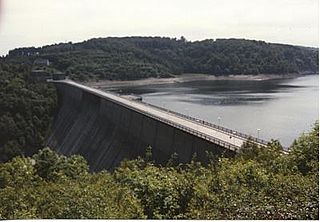
The Rappbode Dam is the largest dam in the Harz region as well as the highest dam in Germany. Together with several other dams and retention basins, it forms the flood protection system for the eastern Harz.

Lake Senftenberg is an artificial lake in Landkreis Oberspreewald-Lausitz, Brandenburg, Germany. It is located in the Lusatian Lake District, a chain of artificial lakes. The lake is located on the border of Lower and Upper Lusatia between the southern Brandenburg city of Senftenberg and its districts Niemtsch and Großkoschen. Lake Senftenberg is one of the largest artificial lakes in Germany with an area of 1300 hectares.
The Söse Dam is a dam in the Lower Saxon part of the Harz mountains near Osterode in the German state of Lower Saxony.

The Königshütte Dam is a dam in the German state of Saxony-Anhalt in the Harz mountains. It impounds the River Bode and lies between Königshütte and Susenburg. It is a so-called storage reservoir (Überleitungssperre) forming part of the Rappbode Dam system.

The Wendefurth Dam near Wendefurth in the Harz is one of the dams downstream of the Rappbode Dam, that provides flood protection as well as impounding the River Bode to provide the lower reservoir for the Wendefurth Power Station. In addition it is a bathing lake and also supports fish farming.
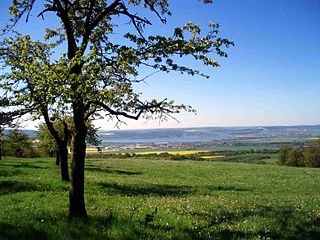
The Kelbra Dam is a dam on the River Helme in the German state of Saxony-Anhalt. Behind the dam is the lake known as the Kelbra Reservoir or Kelbra Flood Retention Basin.
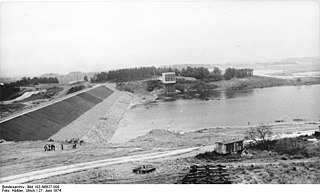
The Bautzen Reservoir, is a reservoir on the River Spree in Germany. It is situated just north of the city of Bautzen in the state of Saxony.

The Saidenbach Dam is a dam in the German state of Saxony. Its reservoir supplies drinking water to Chemnitz and, in conjunction with the Central Ore Mountain Dam System and its other dams - Neunzehnhain I und II and Einsiedel - contributes to the supply of the region covered by the South Saxony Long Distance Water Association.

Eibenstock Dam near Eibenstock in the Ore Mountains, Germany, is the largest dam in the Free State of Saxony in terms of the height of the dam above the valley floor, and its reservoir is the largest in volume in Saxony. The dam impounds the waters of the Zwickauer Mulde and supplies drinking water to the region of Chemnitz and Zwickau, as well as providing flood protection, delivering extra water during times of drought and, to a lesser extent, generating electricity from hydropower. Its dimensions make it the second largest drinking water reservoir in Germany's new federal states.
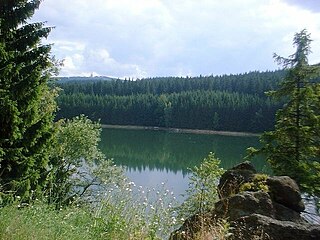
The Sosa Dam is a dam in the Free State of Saxony in East Germany. It supplies drinking water to the Western Ore Mountains as well as acting as flood protection.
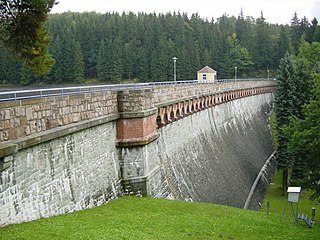
Einsiedel Dam is located in the German Free State of Saxony. Its reservoir supplies drinking water to Chemnitz and, in conjunction with the Central Ore Mountains reservoir system, that includes the reservoirs of Neunzehnhain I, II and Saidenbach also supplies water to the entire region covered by the South Saxony Long Distance Water Association.

The Großer Goitzschesee is the largest lake in the Goitzsche lake district, which emerged from the former Goitzsche brown coal open-cast mine in Saxony-Anhalt. The opencast mine residue lake belongs to the Bitterfeld mining area. The northeastern bay near Mühlbeck is called Amber Lake.

